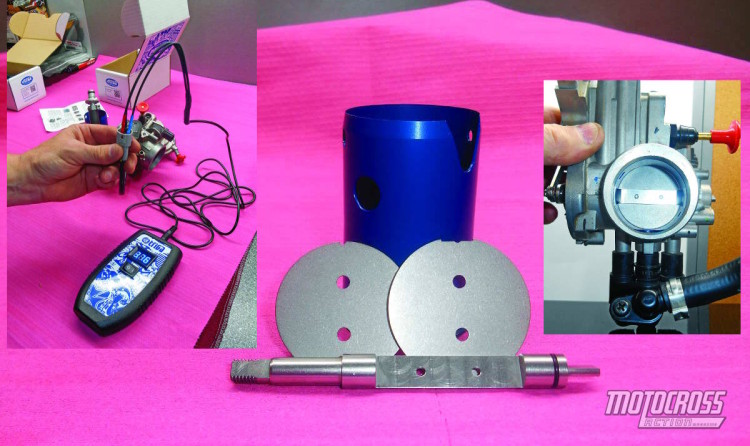MXA TEAM TESTED: TWIN AIR POWERFLOW THROTTLE BODY KIT
WHAT IS IT? The PowerFlow throttle body kit is a sleeve, butterfly valve and butterfly shaft that allows you to reduce the size of your throttle body’s venturi tube.
WHAT’S IT COST? $249.95 (throttle body kit), $79.95 (tuning tool).
CONTACT? www.procircuit.com or (951) 738-8050.
WHAT STANDS OUT? Here’s a list of things that stand out with the PowerFlow throttle body reducer kit.
(1) The kit. The PowerFlow kit includes a blue reducer tube, two butterfly valves (one for the stock bore and one for the smaller tube), a new butterfly shaft (that is thinner and less obstructive), two screws (to attach the butterfly to the shaft) and an instruction sheet. It is available for all modern motocross brands and can be configured to increase top-end power or low-end power by switching out the butterfly valves.
(2) Theory. Just as you could change the size of your old-school Mikuni carb in the two-stroke days, you can change the bore size of your bike’s throttle body with the Twin Air PowerFlow throttle body kit. The manufacturers do change the bore size on their bikes occasionally. KTM went from a 42mm throttle body to a 44mm bore in 2013. Twin Air’s tubular insert reduces the overall flow area and pressure drop, which increases fuel velocity through the intake port. As a rule of thumb, smaller throttle body bore sizes increase throttle response and low-to-mid power, while larger bores decrease low-end throttle response and improve mid-to-top power.
(3) Sizing. MXA chose to install the PowerFlow throttle body in our KTM 350SXF for two reasons. First, the KTM is a high-rpm engine that produces its peak power at 12,800 rpm. We wanted more bottom and mid to make the bike feel like a small 450 instead of a big 250. Second, KTM’s factory race bikes run 42mm throttle bodies instead of the stock 44mm unit. We believed that going smaller would make the bike easier to ride in the lower rpm ranges.
(4) Performance. On the dyno, the PowerFlow throttle body, which downsized the throttle body bore to 41.5mm, didn’t show any significant gains in horsepower, nor any significant losses. But on the track, it was quite different. It was torquier at low rpm and more manageable in the middle. Several test riders said that the bike felt slower, but we chalked this up to a more deliberate power delivery through the middle. Half of the MXA test riders loved the new feel, while the rest preferred the stock high rpm powerband. Novices and Vets thought it was easier to ride, while Pros didn’t want anything to do with it. All agreed that the bike felt more manageable. The PowerFlow kit is all about the feel, not about the numbers.
WHAT’S THE SQUAWK? Three quibbles: (1) Once you install the PowerFlow kit you have to set the Throttle Position Sensor to the correct ohms. Twin Air offers an optional TPS tuning tool, but we just used an ohmmeter. If you don’t know how to set the TPS you will need help. It is tricky. (2) You will need reasonable mechanical skills to tear your throttle body apart and reset the TPS. If you don’t have those skills, you should have a qualified mechanic do the work. (3) At $250 (plus labor if you can’t do it yourself), this is a pricey mod that is best used as part of a comprehensive hop-up program (pipe, porting, mapping, etc).









Comments are closed.